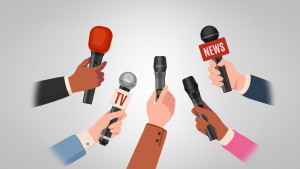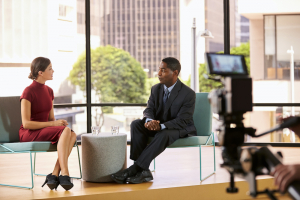-
.
Gareth Davies
Podcast interview with Presenter Trainer Gareth - The Presenter Studio
Our own Gareth had a great chat on the Chatterbeans podcast recently. Talking all things presenting, TV and career.
Take a look here: https://www.chatter-beans.com/latest-episodes
It was so much fun to do!
How to Sound Natural and Confident on Camera
The camera can be intimidating. Even the most confident professionals sometimes freeze or go into performance mode when the red light comes on. But the best media interviews don’t feel performed — they feel real.
So how do you sound natural on camera? The key is to speak like a person, not like a press release. Media training helps you find the balance between professionalism and personality. It’s not about being perfect — it’s about being you, with polish.
Start by knowing your talking points. If you’re clear on what you want to say, you can relax and have a conversation — instead of worrying about getting it right.
Next, think about pace and tone. People often speed up when they’re nervous, which can make you seem rushed or robotic. Slow down just a little, and let your tone be friendly and expressive. It’s okay to smile and show warmth — it helps the audience connect.
Eye contact is also key. If you’re on live TV or doing a recorded interview, keep your eyes on the interviewer or the lens, whichever is appropriate. Avoid darting around or looking distracted. The more grounded you are, the more confident you’ll appear.
Ultimately, great media interviews don’t happen by chance. They’re the result of preparation, practice, and knowing how to bring your best self to the screen.
For more information about our training programmes visit: https://www.presenterstudio.com/business-presenter-training/media-training
The Biggest Mistake People Make in Media Interviews
If there’s one mistake people consistently make in media interviews, it’s this: they forget their message.
Under pressure, it’s easy to go off on a tangent, give long-winded answers, or try to say too much. But the most successful interviews are the ones where the speaker is focused, clear, and in control of what they want the audience to remember.
That’s where media training comes in. It helps you identify your key messages — the core points you want to land — and shows you how to weave them naturally into conversation. No matter what question you’re asked, you’ll learn how to bridge back to what matters.
This doesn’t mean ignoring the question. It means answering it in a way that still delivers value to your audience and reinforces your message. It’s about balance — being authentic while staying strategic.
So if you’re ever in a situation where you need to represent yourself or your company in the media, remember this: preparation beats improvisation. Know your message, practise your delivery, and you’ll come across as confident and credible.
For more information about our training programmes visit: https://www.presenterstudio.com/business-presenter-training/media-training
Why Media Training Is Essential for Modern Professionals
In today’s fast-moving digital world, the media can be your greatest opportunity — or your biggest risk. That’s why media training is no longer just for celebrities or politicians. It’s a vital skill for anyone representing a brand or business.
When you're being interviewed, how you say something matters just as much as what you say. Media training helps you learn how to deliver your message clearly, confidently, and with purpose — whether it's on camera, in print, or across social media.
It also prepares you for pressure. Interviews can be unpredictable, and without the right tools, it’s easy to get thrown off track. Media training teaches you how to stay calm, avoid being misquoted, and handle difficult questions with professionalism.
Most importantly, it helps you speak like a real person. Audiences connect with authenticity — not jargon or rehearsed statements. Great media interviews feel conversational, natural, and honest.
If you're a business leader, spokesperson, or expert in your field, media training should be part of your professional toolkit. It's about protecting your brand, owning your story, and making your voice count.
For more information about our training programmes visit: https://www.presenterstudio.com/business-presenter-training/media-training
The Secret to Engaging Public Speaking? Be Yourself
One of the biggest myths about public speaking is that you have to perform or become someone else. In reality, the most powerful speakers are the ones who sound like themselves.
Audiences respond to authenticity. They don’t want perfection — they want connection. So if you trip over a word or lose your place, it’s not the end of the world. What matters more is whether they believe you and relate to you.
Use language you would use in a conversation. Speak naturally, as if you’re talking to just one person in the room. This creates a feeling of intimacy, even with a large audience.
Let your personality come through. If you’re passionate, show it. If you’re thoughtful, lean into that tone. You don’t have to be loud to make an impact — you just need to be real.
Authentic public speaking builds trust. When people feel like they’re hearing the real you, they’re more likely to listen — and more likely to remember what you said.
So before your next presentation, ask yourself: am I being the best version of myself, or am I trying to be someone I’m not? The more you bring yourself to the stage, the more powerful your message becomes.
For more information about our training programmes visit: https://www.presenterstudio.com/business-presenter-training/presentation-skills-training
How to Be a More Confident Public Speaker
Confidence is one of the first things people look for in a speaker. But here’s the secret — confidence isn’t something you have or don’t have. It’s something you can build.
The first step is preparation. Knowing your material inside out gives you a strong foundation to fall back on. If you’re confident in what you’re saying, it shows.
Next is how you carry yourself. Body language and posture speak before your words do. Stand tall, take a breath, and look your audience in the eye. Even if you don’t feel confident, acting confident helps shift your mindset.
Don’t be afraid of pausing. Silence gives weight to your words and gives your audience time to absorb what you’re saying. It also gives you space to think.
Reframe nerves as excitement. The physical symptoms are similar — racing heart, butterflies — but the way you interpret them makes all the difference.
And remember, the audience is on your side. They want you to do well. When you focus on the message rather than yourself, your nerves start to ease.
Confidence grows the more you practise. Keep saying yes to opportunities, and over time, public speaking will feel more natural.
For more information about our training programmes visit: https://www.presenterstudio.com/business-presenter-training/presentation-skills-training
Why Storytelling Is the Secret Weapon of Great Presenters
How to Overcome Nerves Before a Big Presentation
Everyone feels nervous before a big presentation — it’s completely normal. Even experienced speakers feel the adrenaline rise. The difference is in how you manage it.
Start by visualising a successful outcome. See yourself walking into the room, speaking clearly, and getting a positive response. This simple shift in mindset can help quiet your doubts.
Take time to breathe deeply before you begin. A few slow breaths can bring your heart rate down and help you feel more grounded.
One of the best ways to calm nerves is to know exactly how you're going to start. Memorise your first few lines so you can ease into the presentation with confidence and set the tone straight away.
The way you carry yourself physically has a huge impact too. Stand tall, smile, and make eye contact. When you act confident, your brain starts to believe it.
It also helps to practise with someone you trust. A friendly face giving honest feedback can help ease the pressure and boost your confidence.
Remember, nerves mean you care — and that’s a good thing. With the right techniques, you can turn anxiety into positive energy and deliver a presentation that lands.
For more information about our training programmes visit: https://www.presenterstudio.com/business-presenter-training/presentation-skills-training
5 Easy Ways to Improve Your Presentation Skills Today
Great presenters aren’t born — they’re made. Whether you're leading a team meeting or pitching to a new client, improving your presentation skills can transform the way people respond to you.
One of the first steps is to make sure you have a clear message. Know what your main point is, and ensure everything you say supports it. Clarity helps your audience follow you — and makes you more memorable.
Practice is essential. But don’t just go over your slides silently in your head. Rehearsing out loud helps you become familiar with your flow and highlights anything that feels awkward or unclear.
When nerves kick in, many people speak too fast. Slowing down helps you breathe, think more clearly, and gives your audience time to absorb your message.
Your body language also plays a key role. Standing tall, using open gestures, and making eye contact will help you come across as confident and engaged — even if you’re nervous inside.
And finally, remember to connect. Presenting is a two-way experience, even if you’re the only one talking. Speak in a conversational tone, show some personality, and let your passion for the topic come through.
Presenting well is something anyone can learn. With a few changes to your approach, you’ll start seeing results straight away.
For more information about our training programmes visit: https://www.presenterstudio.com/business-presenter-training/presentation-skills-training
What the Wimbledon Final Teaches Us About the Power of Kindness in Presenting
Did you see the speeches at the end of the men’s final at Wimbledon? After hours of high-stakes tennis, what stood out just as much as the athletic brilliance was how both players handled the spotlight with kindness, humility, and heartfelt appreciation.
The finalists didn’t just talk about their own achievements. They thanked each other, recognised their teams, and even gave a nod to the ball boys and girls. It was a moment of grace, warmth, and genuine human connection — and the crowd loved it.
So what can this teach us about how to present and communicate better in our own lives — especially at work?
Far too often, business presentations are stiff, overly rehearsed, or packed with facts but lacking any emotional connection. But what we saw on that Centre Court stage was a masterclass in presenting with heart. The players were vulnerable, appreciative, and above all — kind. And because of that, we warmed to them. We listened. We respected them more.
That’s the power of kindness in presenting.
When you come across as warm and sincere, your audience is more likely to engage with you. They trust you. They want to hear more. That doesn’t mean dumbing things down or performing a version of yourself that feels false. It simply means showing a little humanity — recognising the team behind the work, appreciating your audience’s time, and communicating in a way that feels real.
So next time you're preparing for a big pitch or a team update, take a moment to ask yourself:
-
Am I showing appreciation for the people around me?
-
Am I speaking with warmth?
-
How can I make this more human?
Kindness costs nothing — but in presenting, it could be the most powerful tool you have.
For more information about our training programmes visit:











